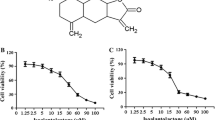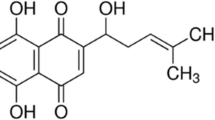Abstract
We have previously shown that protein kinase Cε (PKCε) acts as an antiapoptotic protein and protects breast cancer MCF-7 cells from tumor necrosis factor-α (TNF)-mediated apoptosis. In the present study, we have investigated the mechanism by which PKCε inhibits TNF-induced cell death. Overexpression of wild-type PKCε (WT-PKCε) in MCF-7 cells decreased TNF-induced mitochondrial depolarization. Depletion of Bax by small interfering RNA (siRNA) attenuated TNF-induced cell death. Overexpression of PKCε in MCF-7 cells decreased dimerization of Bax and its translocation to the mitochondria. Knockdown of PKCε using siRNA induced Bax dimerization and mitochondrial translocation. PKCε was coimmunoprecipitated with Bax in MCF-7 cells. These results suggest that PKCε mediates its antiapoptotic effect partly by preventing activation and translocation of Bax to the mitochondria.








Similar content being viewed by others
References
Carswell EA, Old LJ, Kassel RL et al (1975) An endotoxin induced serum factor that causes necrosis of tumors. Procnatacadsciusa 72:3666–3670
Lewis M, Tartaglia LA, Lee A et al (1991) Cloning and expression of cDNAs for two distinct murine tumor necrosis factor receptors demonstrate one receptor is species specific. Proc Natl Acad Sci USA 88:2830–2834
Schall TJ, Lewis M, Koller KJ et al (1990) Molecular cloning and expression of a receptor for human tumor necrosis factor. Cell 61:361–370
Sugarman BJ, Aggarwal BB, Hass PE et al (1985) Recombinant human tumor necrosis factor-[alpha]: effects on proliferation of normal and transformed cells in vitro. Science 230:943–945
Creasey AA, Yamamoto R, Vitt CR (1987) A high molecular weight component of the human tumor necrosis factor receptor is associated with cytotoxicity. Proc Natl Acad Sci USA 84:3293–3297
Smith CA, Davis T, Anderson D et al (1990) A receptor for tumor necrosis factor defines an unusual family of cellular and viral proteins. Science 248:1019–1023
Salvesen GS, Dixit VM (1997) Caspases: intracellular signaling by proteolysis. Cell 91:443–446
Thornberry NA, Lazebnik Y (1998) Caspases: enemies within. Science 281:1312–1316
Kischkel FC, Hellbardt S, Behrmann I et al (1995) Cytotoxicity-dependent APO-1 (Fas/CD95)-associated proteins form a death-inducing signaling complex (DISC) with the receptor. EMBO J 14:5579–5588
Krammer PH (2000) CD95’s deadly mission in the immune system. Nature 407:789–795
Eskes R, Desagher S, Antonsson B, Martinou JC (2000) Bid induces the oligomerization and insertion of Bax into the outer mitochondrial membrane. Mol Cell Biol 20:929–935
Gross A, Yin XM, Wang K et al (1999) Caspase cleaved BID targets mitochondria and is required for cytochrome c release, while BCL-XL prevents this release but not tumor necrosis factor-R1/Fas death. J Biol Chem 274:1156–1163
Rudner J, Jendrossek V, Lauber K, Daniel PT, Wesselborg S, Belka C (2005) Type I and type II reactions in TRAIL-induced apoptosis – results from dose–response studies. Oncogene 24:130–140
Wang K, Yin XM, Chao DT, Milliman CL, Korsmeyer SJ (1996) BID: a novel BH3 domain-only death agonist. Genes Dev 10:2859–2869
Hsu YT, Youle RJ (1998) Bax in murine thymus is a soluble monomeric protein that displays differential detergent-induced conformations. J Biol Chem 273:10777–10783
Wolter KG, Hsu YT, Smith CL, Nechushtan A, Xi XG, Youle RJ (1997) Movement of Bax from the cytosol to mitochondria during apoptosis. J Cell Biol 139:1281–1292
Cory S, Adams JM (2002) The Bcl2 family: regulators of the cellular life-or-death switch. Nat Rev Cancer 2:647–656
Gillespie S, Zhang XD, Hersey P (2005) Variable expression of protein kinase C epsilon in human melanoma cells regulates sensitivity to TRAIL-induced apoptosis. Mol Cancer Ther 4:668–676
Ravi R, Bedi A (2002) Requirement of BAX for TRAIL/Apo2L-induced apoptosis of colorectal cancers: synergism with sulindac-mediated inhibition of Bcl-x(L). Cancer Res 62:1583–1587
McJilton MA, Van Sikes C, Wescott GG et al (2003) Protein kinase Cepsilon interacts with Bax and promotes survival of human prostate cancer cells. Oncogene 22:7958–7968
Basu A, Lu D, Sun B, Moor AN, Akkaraju GR, Huang J (2002) Proteolytic activation of protein kinase C-epsilon by caspase-mediated processing and transduction of antiapoptotic signals. J Biol Chem 277:41850–41856
Lu D, Huang J, Basu A (2006) Protein kinase Cepsilon activates protein kinase B/Akt via DNA-PK to protect against tumor necrosis factor-alpha-induced cell death. J Biol Chem 281:22799–22807
Sivaprasad U, Shankar E, Basu A (2007) Downregulation of Bid is associated with PKCvarepsilon-mediated TRAIL resistance. Cell Death Differ 14:851–860
Basu A, Akkaraju GR (1999) Regulation of caspase activation and cis-diamminedichloroplatinum(II)-induced cell death by protein kinase C. Biochemistry 38:4245–4251
Gross A, Jockel J, Wei MC, Korsmeyer SJ (1998) Enforced dimerization of BAX results in its translocation, mitochondrial dysfunction and apoptosis. EMBO J 17:3878–3885
Sundararajan R, White E (2001) E1B 19K blocks Bax oligomerization and tumor necrosis factor alpha-mediated apoptosis. J Virol 75:7506–7516
Cory S, Huang D, Adams J (2003) The Bcl-2 family: roles in cell survival and oncogenesis. Oncogene 22:8590–8607
Antonsson B, Montessuit S, Sanchez B, Martinou J-C (2001) Bax is present as a high molecular weight oligomer/complex in the mitochondrial membrane of apoptotic cells. J Biol Chem 276:11615–11623
Gardai SJ, Hildeman DA, Frankel SK et al (2004) Phosphorylation of Bax Ser184 by Akt regulates its activity and apoptosis in neutrophils. J Biol Chem 279:21085–21095
Guo B, Zhai D, Cabezas E et al (2003) Humanin peptide suppresses apoptosis by interfering with Bax activation. Nature 423:456–461
Sawada M, Sun W, Hayes P, Leskov K, Boothman DA, Matsuyama S (2003) Ku70 suppresses the apoptotic translocation of Bax to mitochondria. Nat Cell Biol 5:320–329
Nomura M, Shimizu S, Sugiyama T et al (2003) 14-3-3 interacts directly with and negatively regulates pro-apoptotic Bax. J Biol Chem 278:2058–2065
Tsuruta F, Sunayama J, Mori Y et al (2004) JNK promotes Bax translocation to mitochondria through phosphorylation of 14-3-3 proteins. EMBO J 23:1889–1899
Acknowledgement
This work is supported by the grant R01 CA71727 (A. Basu) from the NIH/NCI.
Author information
Authors and Affiliations
Corresponding author
Rights and permissions
About this article
Cite this article
Lu, D., Sivaprasad, U., Huang, J. et al. Protein kinase C-ε protects MCF-7 cells from TNF-mediated cell death by inhibiting Bax translocation. Apoptosis 12, 1893–1900 (2007). https://doi.org/10.1007/s10495-007-0111-7
Published:
Issue Date:
DOI: https://doi.org/10.1007/s10495-007-0111-7




